Business Models and Development
VerifiedAdded on 2020/03/04
|9
|2015
|59
Essay
AI Summary
This essay discusses the importance of business models in organizational development, focusing on e-business, active business models, and revenue strategies. It highlights how these models can enhance clarity and innovation in business practices, using examples like Louis Vuitton to illustrate the evolution of business strategies over time.
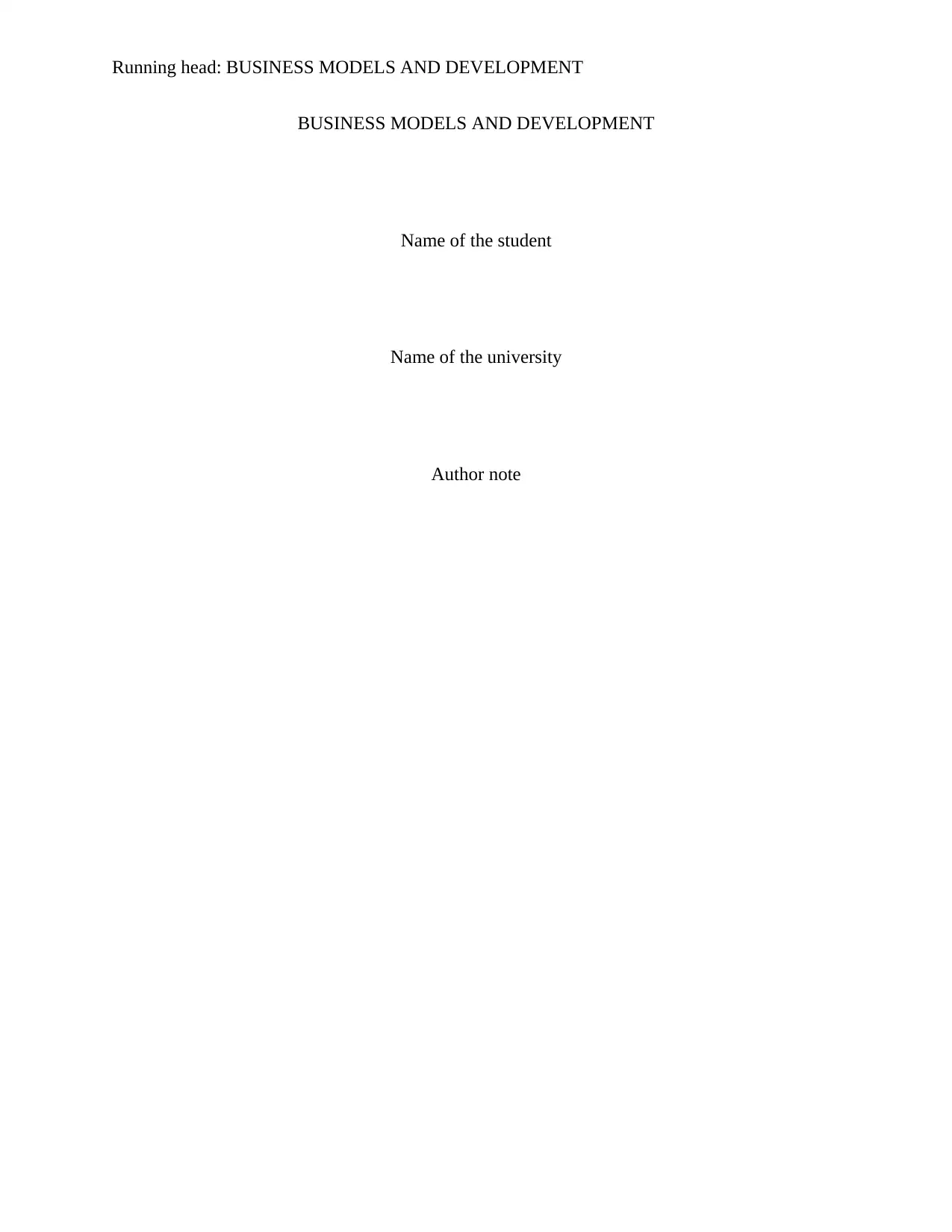
Running head: BUSINESS MODELS AND DEVELOPMENT
BUSINESS MODELS AND DEVELOPMENT
Name of the student
Name of the university
Author note
BUSINESS MODELS AND DEVELOPMENT
Name of the student
Name of the university
Author note
Paraphrase This Document
Need a fresh take? Get an instant paraphrase of this document with our AI Paraphraser
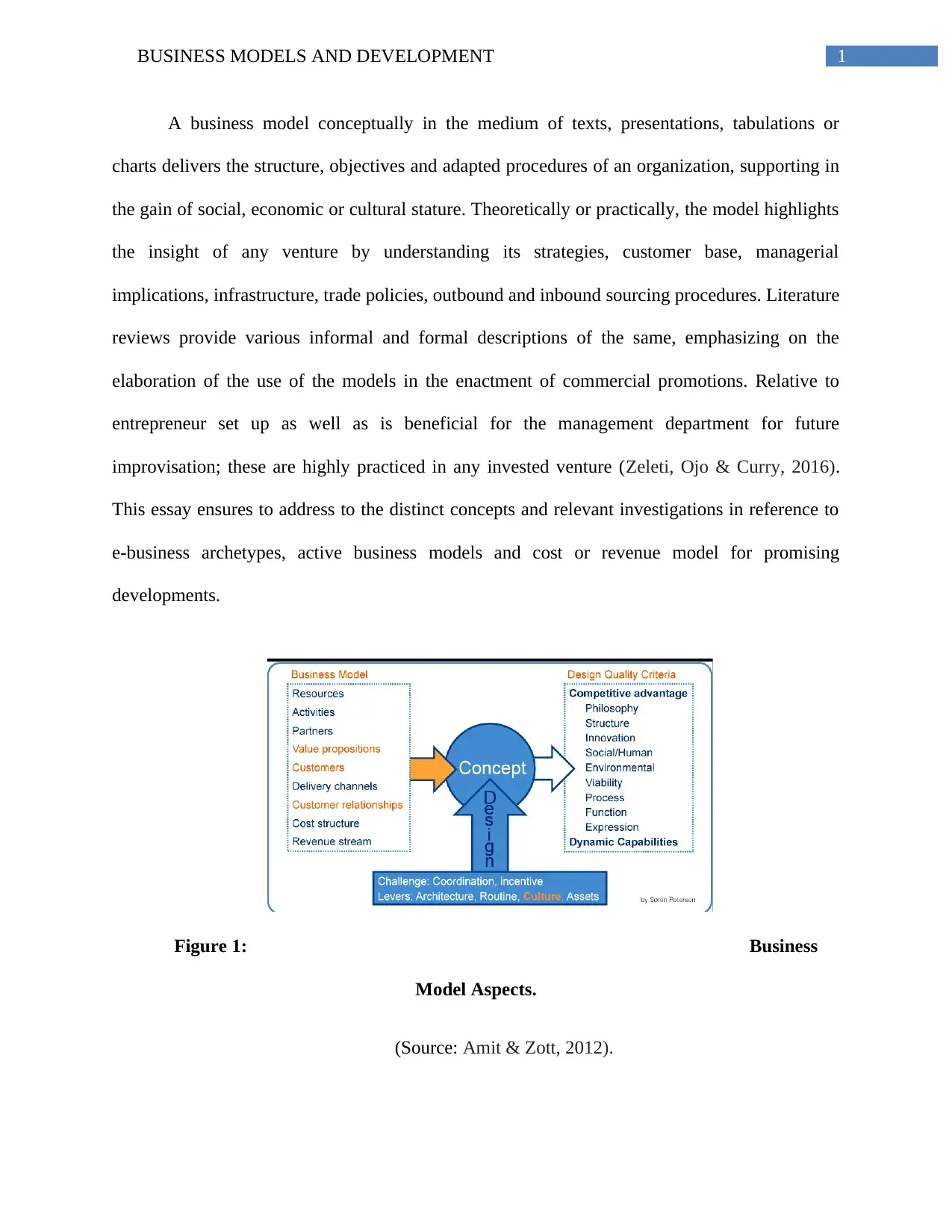
1BUSINESS MODELS AND DEVELOPMENT
A business model conceptually in the medium of texts, presentations, tabulations or
charts delivers the structure, objectives and adapted procedures of an organization, supporting in
the gain of social, economic or cultural stature. Theoretically or practically, the model highlights
the insight of any venture by understanding its strategies, customer base, managerial
implications, infrastructure, trade policies, outbound and inbound sourcing procedures. Literature
reviews provide various informal and formal descriptions of the same, emphasizing on the
elaboration of the use of the models in the enactment of commercial promotions. Relative to
entrepreneur set up as well as is beneficial for the management department for future
improvisation; these are highly practiced in any invested venture (Zeleti, Ojo & Curry, 2016).
This essay ensures to address to the distinct concepts and relevant investigations in reference to
e-business archetypes, active business models and cost or revenue model for promising
developments.
Figure 1: Business
Model Aspects.
(Source: Amit & Zott, 2012).
A business model conceptually in the medium of texts, presentations, tabulations or
charts delivers the structure, objectives and adapted procedures of an organization, supporting in
the gain of social, economic or cultural stature. Theoretically or practically, the model highlights
the insight of any venture by understanding its strategies, customer base, managerial
implications, infrastructure, trade policies, outbound and inbound sourcing procedures. Literature
reviews provide various informal and formal descriptions of the same, emphasizing on the
elaboration of the use of the models in the enactment of commercial promotions. Relative to
entrepreneur set up as well as is beneficial for the management department for future
improvisation; these are highly practiced in any invested venture (Zeleti, Ojo & Curry, 2016).
This essay ensures to address to the distinct concepts and relevant investigations in reference to
e-business archetypes, active business models and cost or revenue model for promising
developments.
Figure 1: Business
Model Aspects.
(Source: Amit & Zott, 2012).
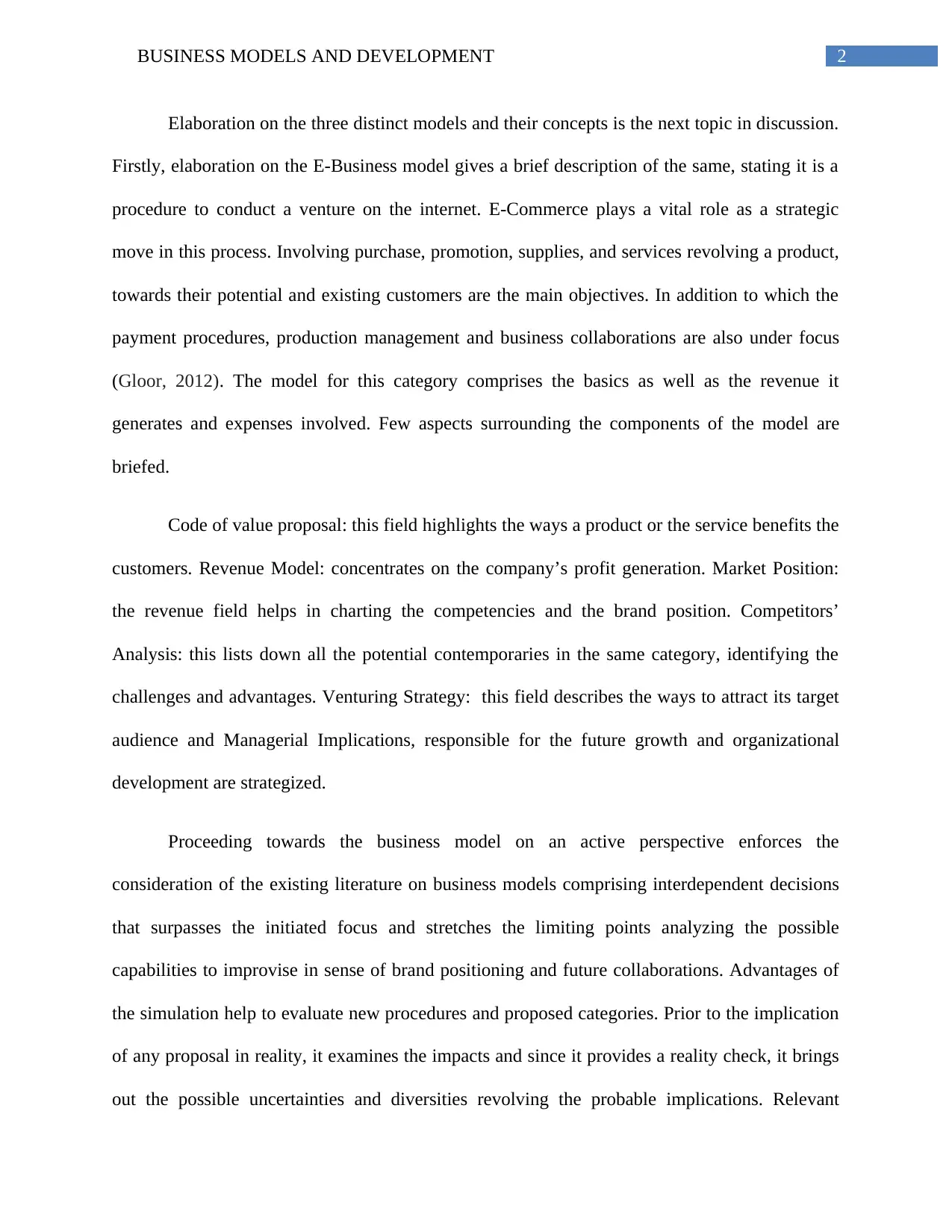
2BUSINESS MODELS AND DEVELOPMENT
Elaboration on the three distinct models and their concepts is the next topic in discussion.
Firstly, elaboration on the E-Business model gives a brief description of the same, stating it is a
procedure to conduct a venture on the internet. E-Commerce plays a vital role as a strategic
move in this process. Involving purchase, promotion, supplies, and services revolving a product,
towards their potential and existing customers are the main objectives. In addition to which the
payment procedures, production management and business collaborations are also under focus
(Gloor, 2012). The model for this category comprises the basics as well as the revenue it
generates and expenses involved. Few aspects surrounding the components of the model are
briefed.
Code of value proposal: this field highlights the ways a product or the service benefits the
customers. Revenue Model: concentrates on the company’s profit generation. Market Position:
the revenue field helps in charting the competencies and the brand position. Competitors’
Analysis: this lists down all the potential contemporaries in the same category, identifying the
challenges and advantages. Venturing Strategy: this field describes the ways to attract its target
audience and Managerial Implications, responsible for the future growth and organizational
development are strategized.
Proceeding towards the business model on an active perspective enforces the
consideration of the existing literature on business models comprising interdependent decisions
that surpasses the initiated focus and stretches the limiting points analyzing the possible
capabilities to improvise in sense of brand positioning and future collaborations. Advantages of
the simulation help to evaluate new procedures and proposed categories. Prior to the implication
of any proposal in reality, it examines the impacts and since it provides a reality check, it brings
out the possible uncertainties and diversities revolving the probable implications. Relevant
Elaboration on the three distinct models and their concepts is the next topic in discussion.
Firstly, elaboration on the E-Business model gives a brief description of the same, stating it is a
procedure to conduct a venture on the internet. E-Commerce plays a vital role as a strategic
move in this process. Involving purchase, promotion, supplies, and services revolving a product,
towards their potential and existing customers are the main objectives. In addition to which the
payment procedures, production management and business collaborations are also under focus
(Gloor, 2012). The model for this category comprises the basics as well as the revenue it
generates and expenses involved. Few aspects surrounding the components of the model are
briefed.
Code of value proposal: this field highlights the ways a product or the service benefits the
customers. Revenue Model: concentrates on the company’s profit generation. Market Position:
the revenue field helps in charting the competencies and the brand position. Competitors’
Analysis: this lists down all the potential contemporaries in the same category, identifying the
challenges and advantages. Venturing Strategy: this field describes the ways to attract its target
audience and Managerial Implications, responsible for the future growth and organizational
development are strategized.
Proceeding towards the business model on an active perspective enforces the
consideration of the existing literature on business models comprising interdependent decisions
that surpasses the initiated focus and stretches the limiting points analyzing the possible
capabilities to improvise in sense of brand positioning and future collaborations. Advantages of
the simulation help to evaluate new procedures and proposed categories. Prior to the implication
of any proposal in reality, it examines the impacts and since it provides a reality check, it brings
out the possible uncertainties and diversities revolving the probable implications. Relevant
⊘ This is a preview!⊘
Do you want full access?
Subscribe today to unlock all pages.

Trusted by 1+ million students worldwide
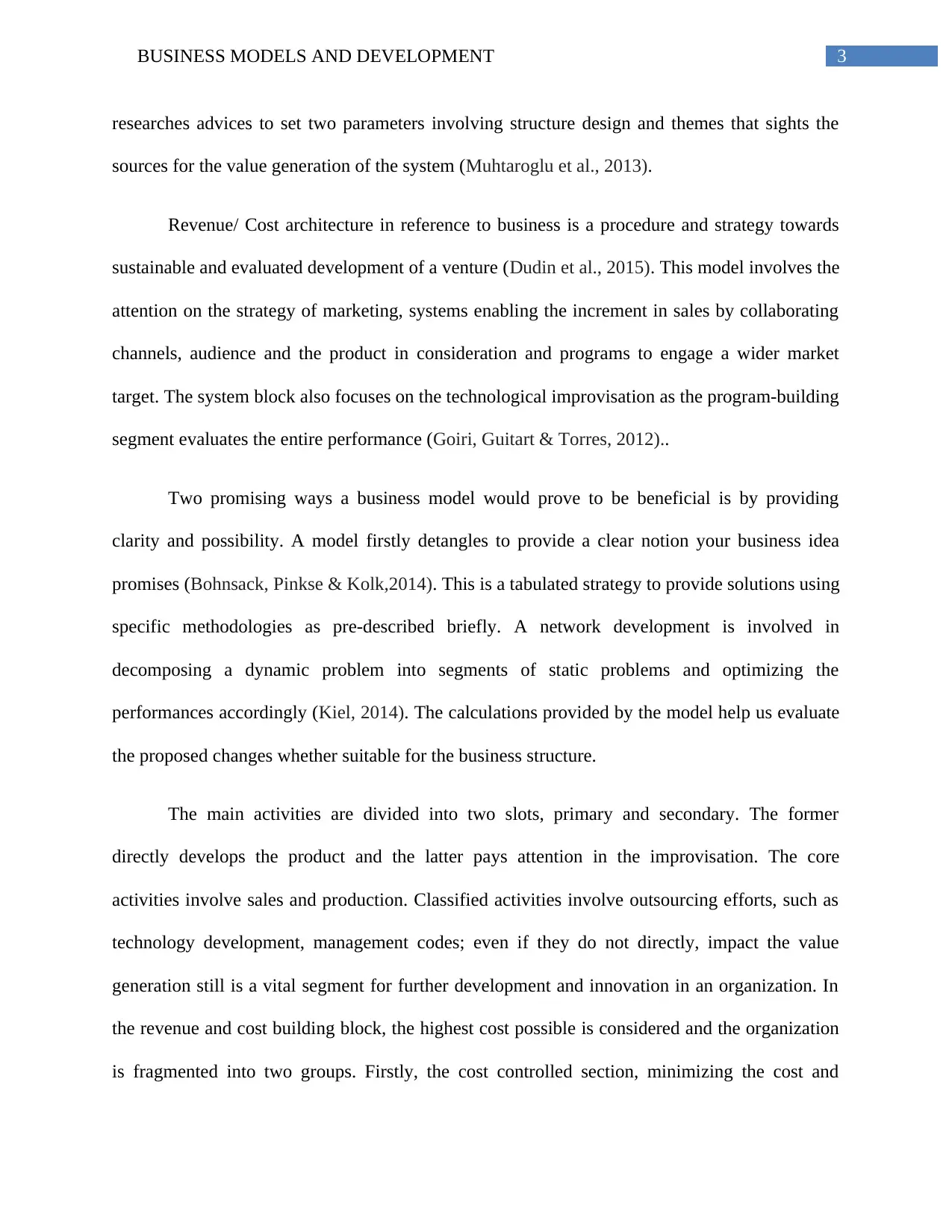
3BUSINESS MODELS AND DEVELOPMENT
researches advices to set two parameters involving structure design and themes that sights the
sources for the value generation of the system (Muhtaroglu et al., 2013).
Revenue/ Cost architecture in reference to business is a procedure and strategy towards
sustainable and evaluated development of a venture (Dudin et al., 2015). This model involves the
attention on the strategy of marketing, systems enabling the increment in sales by collaborating
channels, audience and the product in consideration and programs to engage a wider market
target. The system block also focuses on the technological improvisation as the program-building
segment evaluates the entire performance (Goiri, Guitart & Torres, 2012)..
Two promising ways a business model would prove to be beneficial is by providing
clarity and possibility. A model firstly detangles to provide a clear notion your business idea
promises (Bohnsack, Pinkse & Kolk,2014). This is a tabulated strategy to provide solutions using
specific methodologies as pre-described briefly. A network development is involved in
decomposing a dynamic problem into segments of static problems and optimizing the
performances accordingly (Kiel, 2014). The calculations provided by the model help us evaluate
the proposed changes whether suitable for the business structure.
The main activities are divided into two slots, primary and secondary. The former
directly develops the product and the latter pays attention in the improvisation. The core
activities involve sales and production. Classified activities involve outsourcing efforts, such as
technology development, management codes; even if they do not directly, impact the value
generation still is a vital segment for further development and innovation in an organization. In
the revenue and cost building block, the highest cost possible is considered and the organization
is fragmented into two groups. Firstly, the cost controlled section, minimizing the cost and
researches advices to set two parameters involving structure design and themes that sights the
sources for the value generation of the system (Muhtaroglu et al., 2013).
Revenue/ Cost architecture in reference to business is a procedure and strategy towards
sustainable and evaluated development of a venture (Dudin et al., 2015). This model involves the
attention on the strategy of marketing, systems enabling the increment in sales by collaborating
channels, audience and the product in consideration and programs to engage a wider market
target. The system block also focuses on the technological improvisation as the program-building
segment evaluates the entire performance (Goiri, Guitart & Torres, 2012)..
Two promising ways a business model would prove to be beneficial is by providing
clarity and possibility. A model firstly detangles to provide a clear notion your business idea
promises (Bohnsack, Pinkse & Kolk,2014). This is a tabulated strategy to provide solutions using
specific methodologies as pre-described briefly. A network development is involved in
decomposing a dynamic problem into segments of static problems and optimizing the
performances accordingly (Kiel, 2014). The calculations provided by the model help us evaluate
the proposed changes whether suitable for the business structure.
The main activities are divided into two slots, primary and secondary. The former
directly develops the product and the latter pays attention in the improvisation. The core
activities involve sales and production. Classified activities involve outsourcing efforts, such as
technology development, management codes; even if they do not directly, impact the value
generation still is a vital segment for further development and innovation in an organization. In
the revenue and cost building block, the highest cost possible is considered and the organization
is fragmented into two groups. Firstly, the cost controlled section, minimizing the cost and
Paraphrase This Document
Need a fresh take? Get an instant paraphrase of this document with our AI Paraphraser
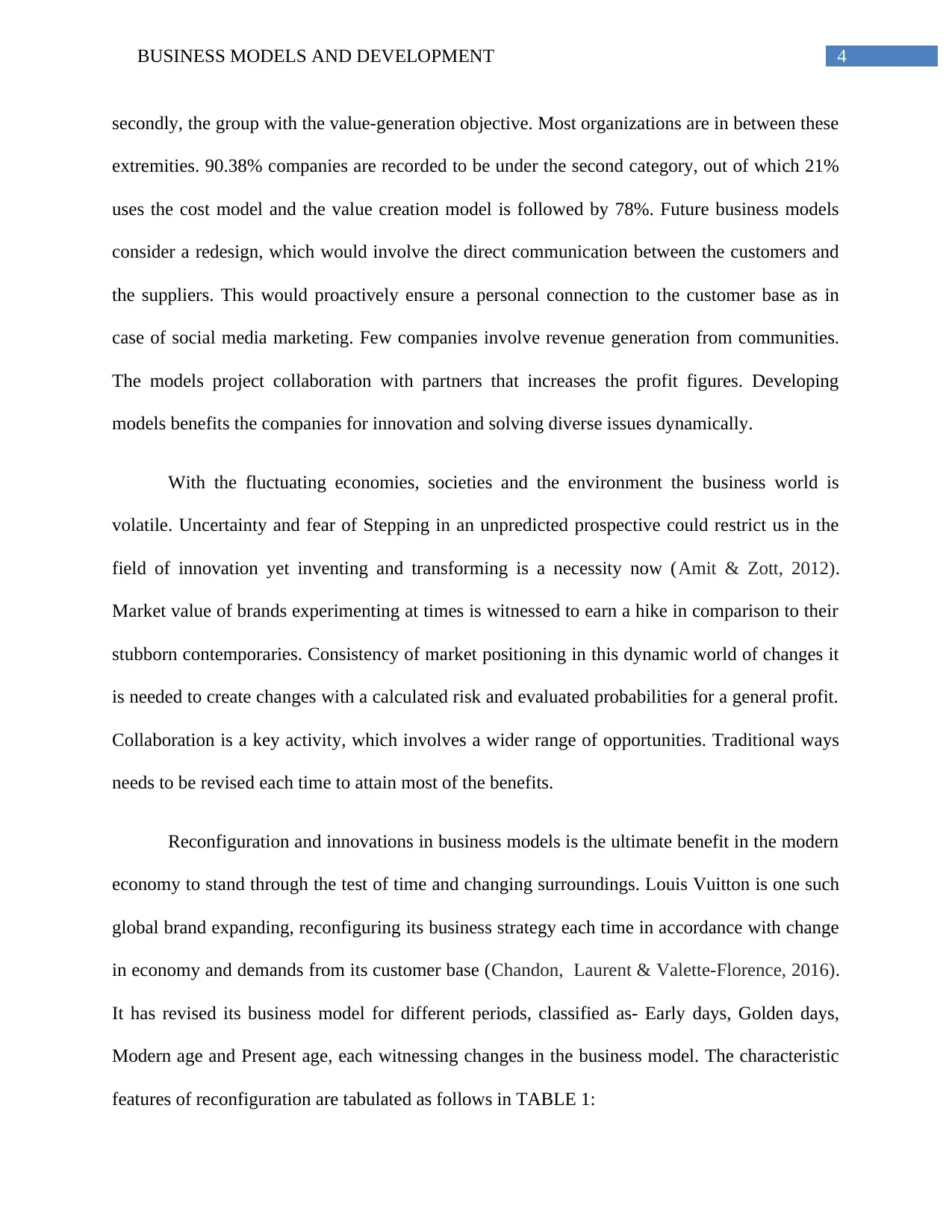
4BUSINESS MODELS AND DEVELOPMENT
secondly, the group with the value-generation objective. Most organizations are in between these
extremities. 90.38% companies are recorded to be under the second category, out of which 21%
uses the cost model and the value creation model is followed by 78%. Future business models
consider a redesign, which would involve the direct communication between the customers and
the suppliers. This would proactively ensure a personal connection to the customer base as in
case of social media marketing. Few companies involve revenue generation from communities.
The models project collaboration with partners that increases the profit figures. Developing
models benefits the companies for innovation and solving diverse issues dynamically.
With the fluctuating economies, societies and the environment the business world is
volatile. Uncertainty and fear of Stepping in an unpredicted prospective could restrict us in the
field of innovation yet inventing and transforming is a necessity now (Amit & Zott, 2012).
Market value of brands experimenting at times is witnessed to earn a hike in comparison to their
stubborn contemporaries. Consistency of market positioning in this dynamic world of changes it
is needed to create changes with a calculated risk and evaluated probabilities for a general profit.
Collaboration is a key activity, which involves a wider range of opportunities. Traditional ways
needs to be revised each time to attain most of the benefits.
Reconfiguration and innovations in business models is the ultimate benefit in the modern
economy to stand through the test of time and changing surroundings. Louis Vuitton is one such
global brand expanding, reconfiguring its business strategy each time in accordance with change
in economy and demands from its customer base (Chandon, Laurent & Valette-Florence, 2016).
It has revised its business model for different periods, classified as- Early days, Golden days,
Modern age and Present age, each witnessing changes in the business model. The characteristic
features of reconfiguration are tabulated as follows in TABLE 1:
secondly, the group with the value-generation objective. Most organizations are in between these
extremities. 90.38% companies are recorded to be under the second category, out of which 21%
uses the cost model and the value creation model is followed by 78%. Future business models
consider a redesign, which would involve the direct communication between the customers and
the suppliers. This would proactively ensure a personal connection to the customer base as in
case of social media marketing. Few companies involve revenue generation from communities.
The models project collaboration with partners that increases the profit figures. Developing
models benefits the companies for innovation and solving diverse issues dynamically.
With the fluctuating economies, societies and the environment the business world is
volatile. Uncertainty and fear of Stepping in an unpredicted prospective could restrict us in the
field of innovation yet inventing and transforming is a necessity now (Amit & Zott, 2012).
Market value of brands experimenting at times is witnessed to earn a hike in comparison to their
stubborn contemporaries. Consistency of market positioning in this dynamic world of changes it
is needed to create changes with a calculated risk and evaluated probabilities for a general profit.
Collaboration is a key activity, which involves a wider range of opportunities. Traditional ways
needs to be revised each time to attain most of the benefits.
Reconfiguration and innovations in business models is the ultimate benefit in the modern
economy to stand through the test of time and changing surroundings. Louis Vuitton is one such
global brand expanding, reconfiguring its business strategy each time in accordance with change
in economy and demands from its customer base (Chandon, Laurent & Valette-Florence, 2016).
It has revised its business model for different periods, classified as- Early days, Golden days,
Modern age and Present age, each witnessing changes in the business model. The characteristic
features of reconfiguration are tabulated as follows in TABLE 1:
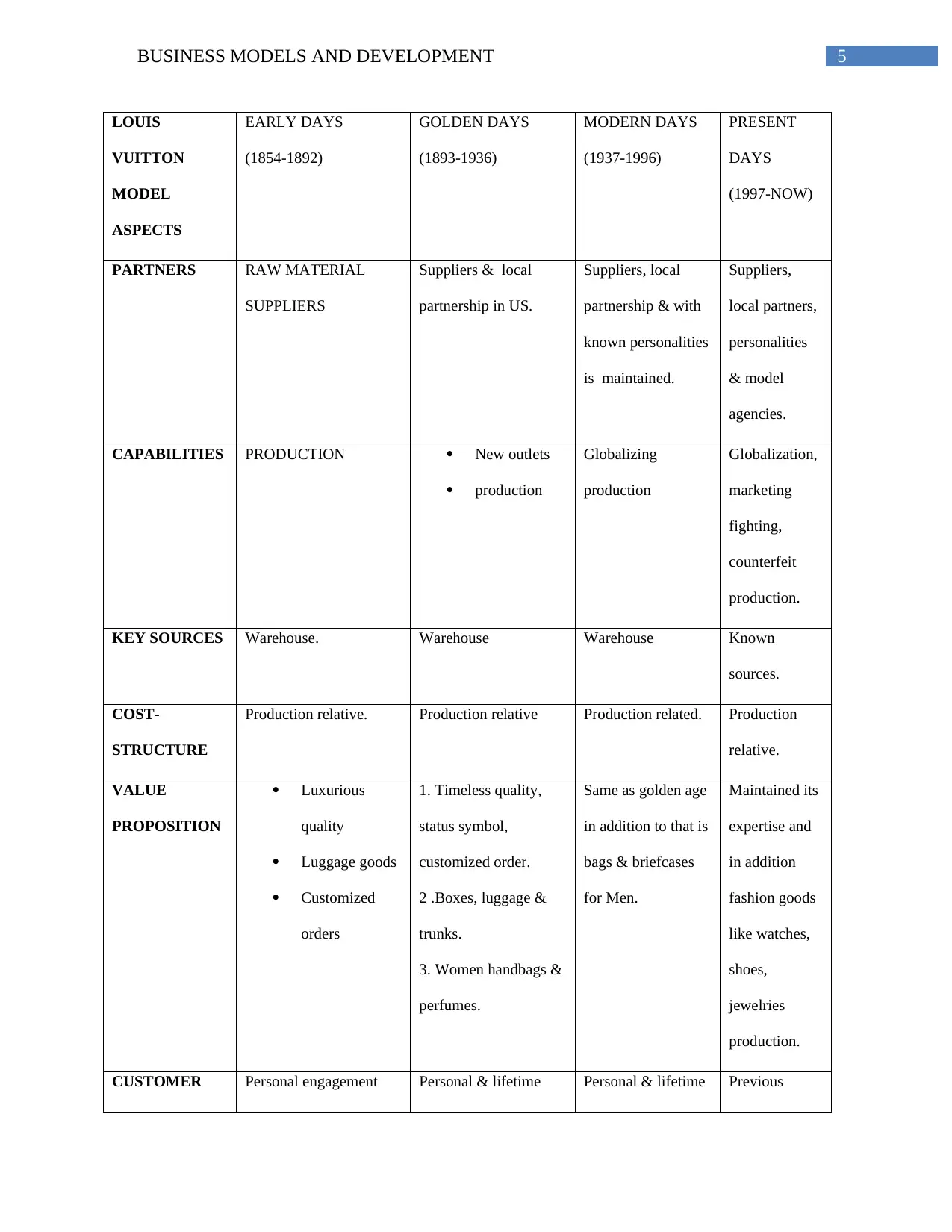
5BUSINESS MODELS AND DEVELOPMENT
LOUIS
VUITTON
MODEL
ASPECTS
EARLY DAYS
(1854-1892)
GOLDEN DAYS
(1893-1936)
MODERN DAYS
(1937-1996)
PRESENT
DAYS
(1997-NOW)
PARTNERS RAW MATERIAL
SUPPLIERS
Suppliers & local
partnership in US.
Suppliers, local
partnership & with
known personalities
is maintained.
Suppliers,
local partners,
personalities
& model
agencies.
CAPABILITIES PRODUCTION New outlets
production
Globalizing
production
Globalization,
marketing
fighting,
counterfeit
production.
KEY SOURCES Warehouse. Warehouse Warehouse Known
sources.
COST-
STRUCTURE
Production relative. Production relative Production related. Production
relative.
VALUE
PROPOSITION
Luxurious
quality
Luggage goods
Customized
orders
1. Timeless quality,
status symbol,
customized order.
2 .Boxes, luggage &
trunks.
3. Women handbags &
perfumes.
Same as golden age
in addition to that is
bags & briefcases
for Men.
Maintained its
expertise and
in addition
fashion goods
like watches,
shoes,
jewelries
production.
CUSTOMER Personal engagement Personal & lifetime Personal & lifetime Previous
LOUIS
VUITTON
MODEL
ASPECTS
EARLY DAYS
(1854-1892)
GOLDEN DAYS
(1893-1936)
MODERN DAYS
(1937-1996)
PRESENT
DAYS
(1997-NOW)
PARTNERS RAW MATERIAL
SUPPLIERS
Suppliers & local
partnership in US.
Suppliers, local
partnership & with
known personalities
is maintained.
Suppliers,
local partners,
personalities
& model
agencies.
CAPABILITIES PRODUCTION New outlets
production
Globalizing
production
Globalization,
marketing
fighting,
counterfeit
production.
KEY SOURCES Warehouse. Warehouse Warehouse Known
sources.
COST-
STRUCTURE
Production relative. Production relative Production related. Production
relative.
VALUE
PROPOSITION
Luxurious
quality
Luggage goods
Customized
orders
1. Timeless quality,
status symbol,
customized order.
2 .Boxes, luggage &
trunks.
3. Women handbags &
perfumes.
Same as golden age
in addition to that is
bags & briefcases
for Men.
Maintained its
expertise and
in addition
fashion goods
like watches,
shoes,
jewelries
production.
CUSTOMER Personal engagement Personal & lifetime Personal & lifetime Previous
⊘ This is a preview!⊘
Do you want full access?
Subscribe today to unlock all pages.

Trusted by 1+ million students worldwide
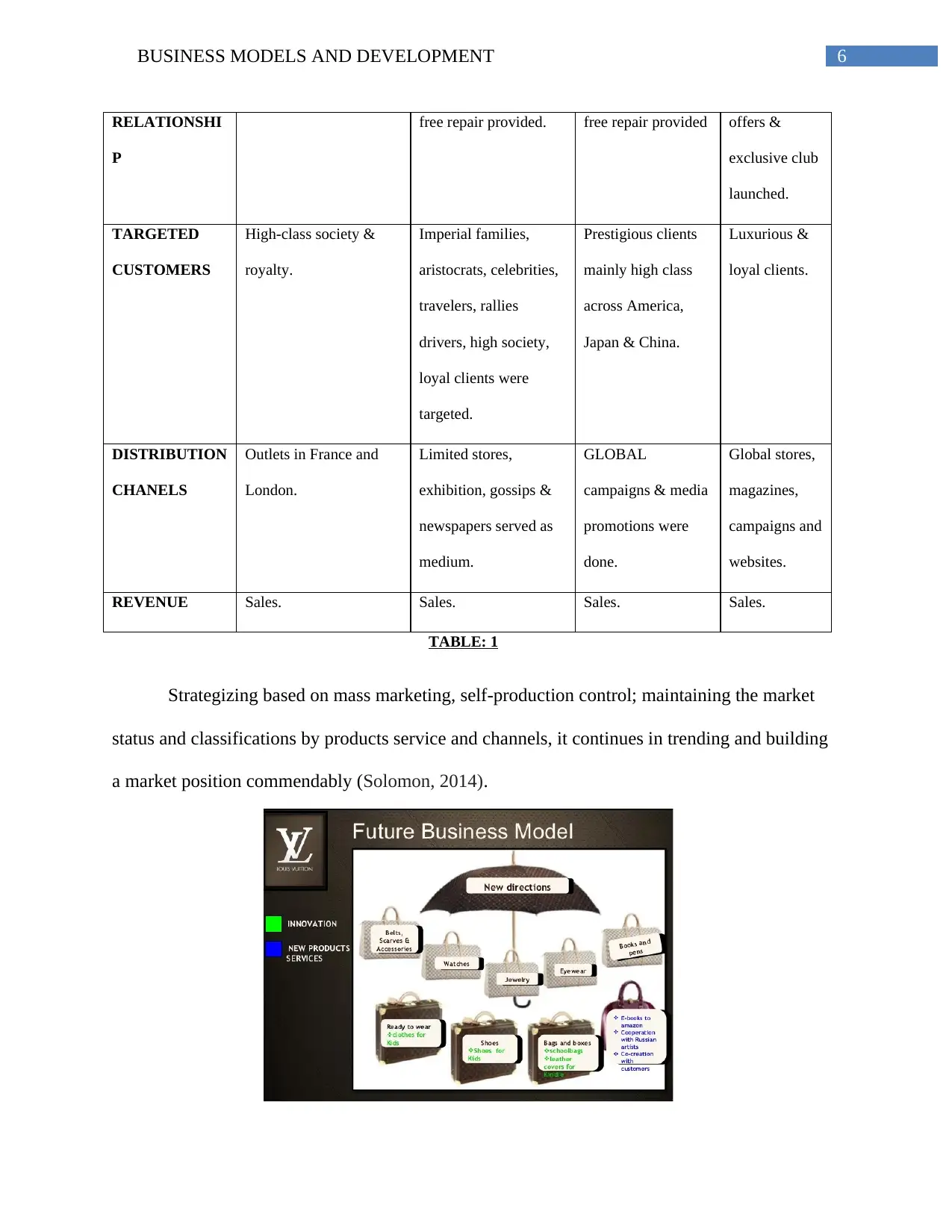
6BUSINESS MODELS AND DEVELOPMENT
RELATIONSHI
P
free repair provided. free repair provided offers &
exclusive club
launched.
TARGETED
CUSTOMERS
High-class society &
royalty.
Imperial families,
aristocrats, celebrities,
travelers, rallies
drivers, high society,
loyal clients were
targeted.
Prestigious clients
mainly high class
across America,
Japan & China.
Luxurious &
loyal clients.
DISTRIBUTION
CHANELS
Outlets in France and
London.
Limited stores,
exhibition, gossips &
newspapers served as
medium.
GLOBAL
campaigns & media
promotions were
done.
Global stores,
magazines,
campaigns and
websites.
REVENUE Sales. Sales. Sales. Sales.
TABLE: 1
Strategizing based on mass marketing, self-production control; maintaining the market
status and classifications by products service and channels, it continues in trending and building
a market position commendably (Solomon, 2014).
RELATIONSHI
P
free repair provided. free repair provided offers &
exclusive club
launched.
TARGETED
CUSTOMERS
High-class society &
royalty.
Imperial families,
aristocrats, celebrities,
travelers, rallies
drivers, high society,
loyal clients were
targeted.
Prestigious clients
mainly high class
across America,
Japan & China.
Luxurious &
loyal clients.
DISTRIBUTION
CHANELS
Outlets in France and
London.
Limited stores,
exhibition, gossips &
newspapers served as
medium.
GLOBAL
campaigns & media
promotions were
done.
Global stores,
magazines,
campaigns and
websites.
REVENUE Sales. Sales. Sales. Sales.
TABLE: 1
Strategizing based on mass marketing, self-production control; maintaining the market
status and classifications by products service and channels, it continues in trending and building
a market position commendably (Solomon, 2014).
Paraphrase This Document
Need a fresh take? Get an instant paraphrase of this document with our AI Paraphraser
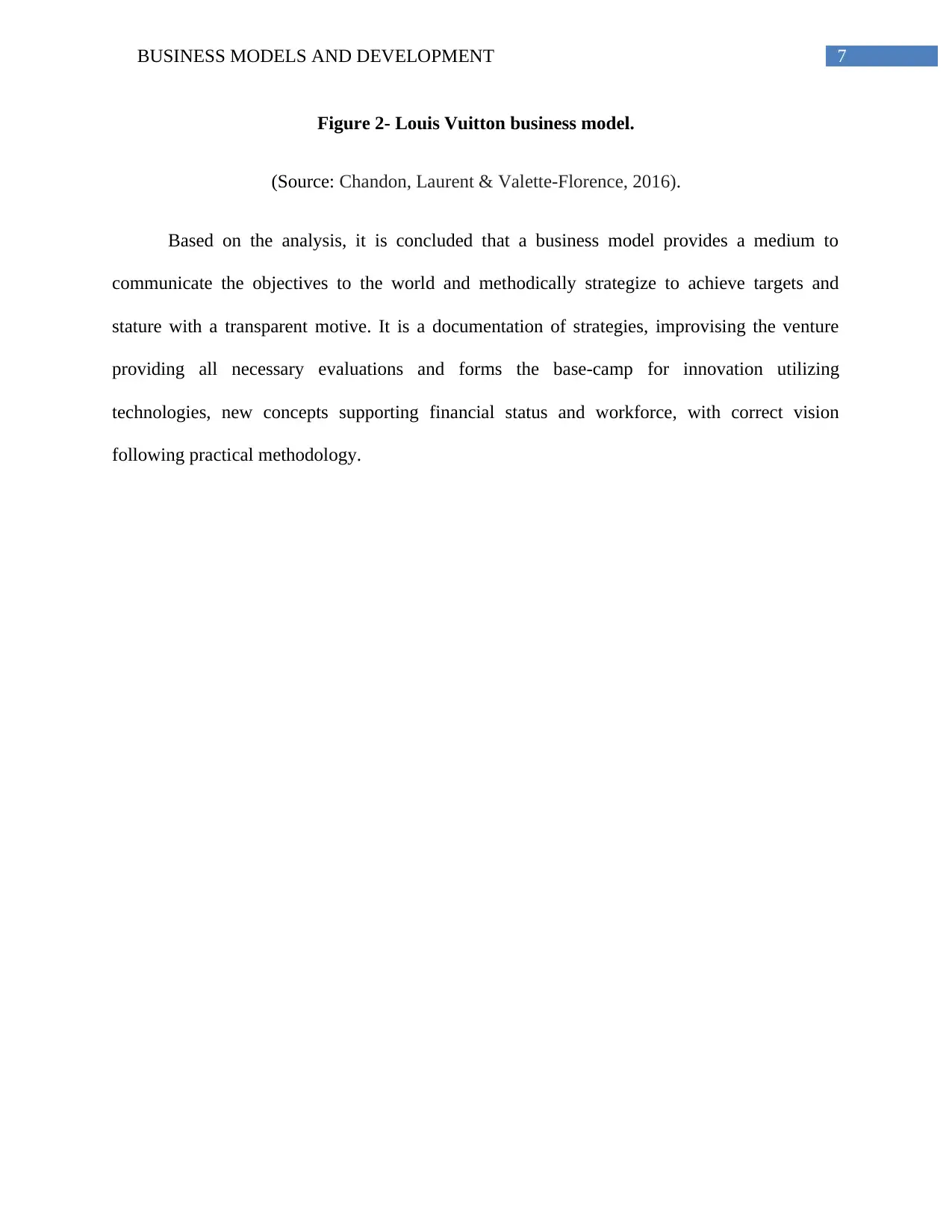
7BUSINESS MODELS AND DEVELOPMENT
Figure 2- Louis Vuitton business model.
(Source: Chandon, Laurent & Valette-Florence, 2016).
Based on the analysis, it is concluded that a business model provides a medium to
communicate the objectives to the world and methodically strategize to achieve targets and
stature with a transparent motive. It is a documentation of strategies, improvising the venture
providing all necessary evaluations and forms the base-camp for innovation utilizing
technologies, new concepts supporting financial status and workforce, with correct vision
following practical methodology.
Figure 2- Louis Vuitton business model.
(Source: Chandon, Laurent & Valette-Florence, 2016).
Based on the analysis, it is concluded that a business model provides a medium to
communicate the objectives to the world and methodically strategize to achieve targets and
stature with a transparent motive. It is a documentation of strategies, improvising the venture
providing all necessary evaluations and forms the base-camp for innovation utilizing
technologies, new concepts supporting financial status and workforce, with correct vision
following practical methodology.
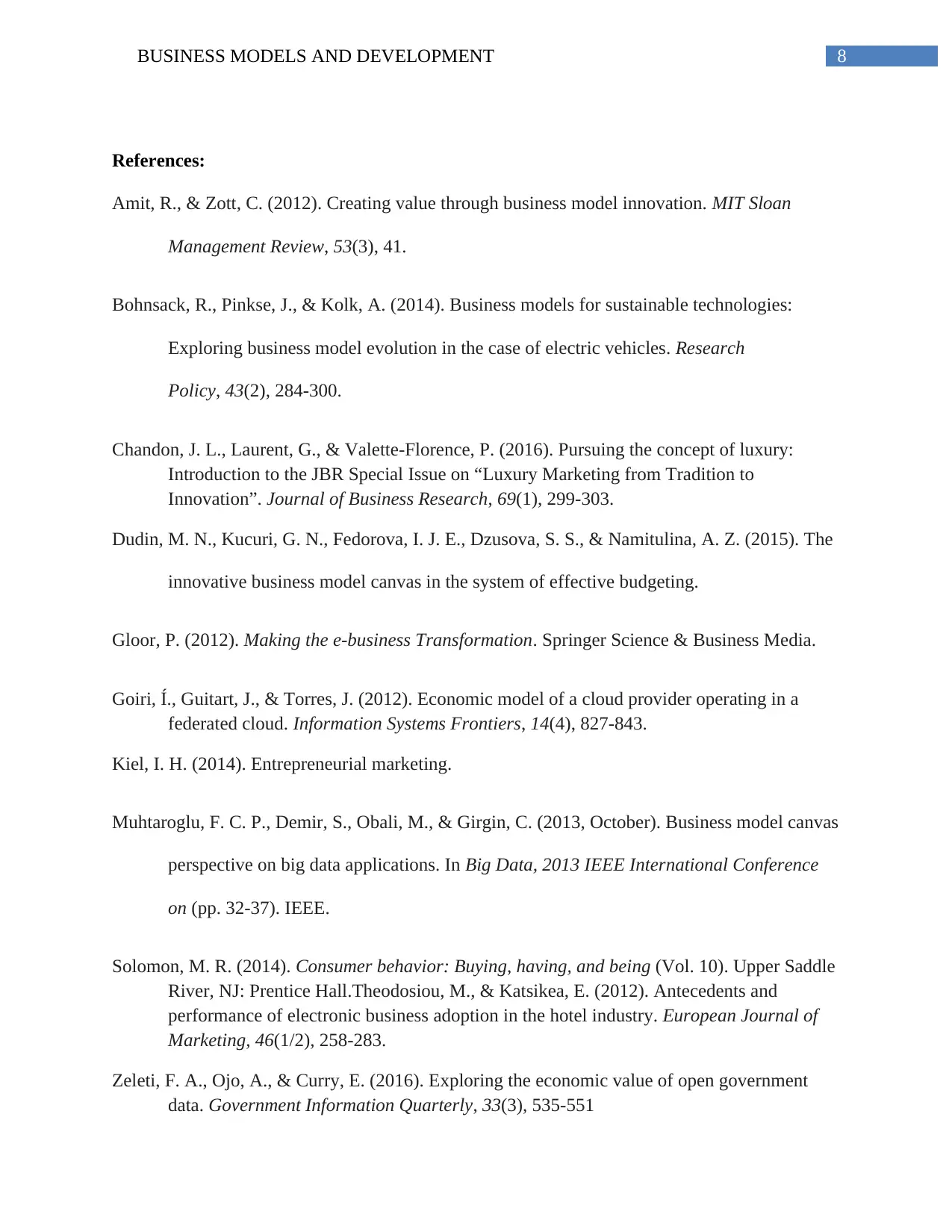
8BUSINESS MODELS AND DEVELOPMENT
References:
Amit, R., & Zott, C. (2012). Creating value through business model innovation. MIT Sloan
Management Review, 53(3), 41.
Bohnsack, R., Pinkse, J., & Kolk, A. (2014). Business models for sustainable technologies:
Exploring business model evolution in the case of electric vehicles. Research
Policy, 43(2), 284-300.
Chandon, J. L., Laurent, G., & Valette-Florence, P. (2016). Pursuing the concept of luxury:
Introduction to the JBR Special Issue on “Luxury Marketing from Tradition to
Innovation”. Journal of Business Research, 69(1), 299-303.
Dudin, M. N., Kucuri, G. N., Fedorova, I. J. E., Dzusova, S. S., & Namitulina, A. Z. (2015). The
innovative business model canvas in the system of effective budgeting.
Gloor, P. (2012). Making the e-business Transformation. Springer Science & Business Media.
Goiri, Í., Guitart, J., & Torres, J. (2012). Economic model of a cloud provider operating in a
federated cloud. Information Systems Frontiers, 14(4), 827-843.
Kiel, I. H. (2014). Entrepreneurial marketing.
Muhtaroglu, F. C. P., Demir, S., Obali, M., & Girgin, C. (2013, October). Business model canvas
perspective on big data applications. In Big Data, 2013 IEEE International Conference
on (pp. 32-37). IEEE.
Solomon, M. R. (2014). Consumer behavior: Buying, having, and being (Vol. 10). Upper Saddle
River, NJ: Prentice Hall.Theodosiou, M., & Katsikea, E. (2012). Antecedents and
performance of electronic business adoption in the hotel industry. European Journal of
Marketing, 46(1/2), 258-283.
Zeleti, F. A., Ojo, A., & Curry, E. (2016). Exploring the economic value of open government
data. Government Information Quarterly, 33(3), 535-551
References:
Amit, R., & Zott, C. (2012). Creating value through business model innovation. MIT Sloan
Management Review, 53(3), 41.
Bohnsack, R., Pinkse, J., & Kolk, A. (2014). Business models for sustainable technologies:
Exploring business model evolution in the case of electric vehicles. Research
Policy, 43(2), 284-300.
Chandon, J. L., Laurent, G., & Valette-Florence, P. (2016). Pursuing the concept of luxury:
Introduction to the JBR Special Issue on “Luxury Marketing from Tradition to
Innovation”. Journal of Business Research, 69(1), 299-303.
Dudin, M. N., Kucuri, G. N., Fedorova, I. J. E., Dzusova, S. S., & Namitulina, A. Z. (2015). The
innovative business model canvas in the system of effective budgeting.
Gloor, P. (2012). Making the e-business Transformation. Springer Science & Business Media.
Goiri, Í., Guitart, J., & Torres, J. (2012). Economic model of a cloud provider operating in a
federated cloud. Information Systems Frontiers, 14(4), 827-843.
Kiel, I. H. (2014). Entrepreneurial marketing.
Muhtaroglu, F. C. P., Demir, S., Obali, M., & Girgin, C. (2013, October). Business model canvas
perspective on big data applications. In Big Data, 2013 IEEE International Conference
on (pp. 32-37). IEEE.
Solomon, M. R. (2014). Consumer behavior: Buying, having, and being (Vol. 10). Upper Saddle
River, NJ: Prentice Hall.Theodosiou, M., & Katsikea, E. (2012). Antecedents and
performance of electronic business adoption in the hotel industry. European Journal of
Marketing, 46(1/2), 258-283.
Zeleti, F. A., Ojo, A., & Curry, E. (2016). Exploring the economic value of open government
data. Government Information Quarterly, 33(3), 535-551
⊘ This is a preview!⊘
Do you want full access?
Subscribe today to unlock all pages.

Trusted by 1+ million students worldwide
1 out of 9
Your All-in-One AI-Powered Toolkit for Academic Success.
+13062052269
info@desklib.com
Available 24*7 on WhatsApp / Email
![[object Object]](/_next/static/media/star-bottom.7253800d.svg)
Unlock your academic potential
Copyright © 2020–2025 A2Z Services. All Rights Reserved. Developed and managed by ZUCOL.


